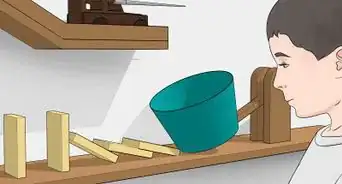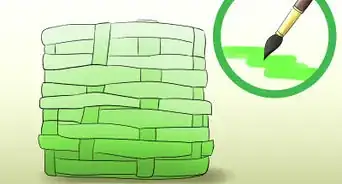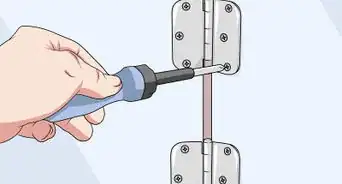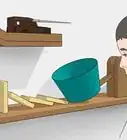This article was co-authored by wikiHow staff writer, Dan Hickey. Dan Hickey is a Writer and Humorist based in Chicago, Illinois. He has published pieces on a variety of online satire sites and has been a member of the wikiHow team since 2022. A former teaching artist at a community music school, Dan enjoys helping people learn new skills they never thought they could master. He graduated with a BM in Clarinet Performance from DePauw University in 2015 and an MM from DePaul University in 2017.
The wikiHow Video Team also followed the article's instructions and verified that they work.
This article has been viewed 18,319 times.
Learn more...
Need something to do while you’re waiting for your sushi to come out? Try making your own hashioki! Hashioki are origami chopstick holders you make yourself out of the wrapper your disposable chopsticks come in. You don't have to be an origami expert to make one—a basic holder is easy to fold in just a few steps, and you can create an impressive bird holder in just a few minutes. If you’re ready to wow your friends next time you’re out to eat, keep scrolling!
Steps
Basic Hashioki
-
1Remove the chopsticks from the wrapper and smooth out the paper. Rip one end of the paper wrapper and slide the chopsticks out. Rest the chopsticks on a plate or napkin and smooth out the paper wrapper so it lays flat on the table.[1]
-
2Fold the wrapper in half so the short ends are touching, then unfold it. The resulting crease shows you the midpoint of the wrapper (you’ll need this for reference later). Press the crease with one finger before you unfold to make it easier to see.[2]Advertisement
-
3Fold in the ends of the wrapper so they meet at the central crease. Press the new creases at the ends down with your fingers so the wrapper lays flat. The wrapper is now half of its original length.[3]
-
4Fold the left side over the right side at the center crease. Flatten the crease with your fingers. The wrapper is now a quarter of its original length.[4]
-
5Fold the wrapper in half lengthwise so the top and bottom edges meet. Flatten the crease through all the layers with your fingers to make a mountain fold. It’s called a mountain fold since the resulting shape can stand up like a mountain or an upside down “V.”[5]
-
6Fold the top left and right corners down so the side edges align with the bottom edge. Flatten the creases, then unfold the corners. The result is your mountain fold from Step 5 with diagonal creases at both ends.[6]
-
7Collapse the ends of the wrapper inward using the creases from Steps 5 and 6. This is called an inside-reverse fold—open up the mountain fold slightly, then push the top corners down and inward.[7] This gives you the triangular “legs” of the hashioki.[8]
- At this point, you have a 3-dimensional trapezoidal shape that can stand on its base.
-
8Push down gently on the center of the top edge to flatten it. This gives you a plateau- or crater-like surface to rest your chopsticks on so they don’t roll or slide off of the stand.[9] Place the mouth-ends of your chopsticks on your new holder and enjoy your meal!
- Practice how to eat with chopsticks like a pro so your skills match your beautiful origami creation.
Hashioki Bird
-
1Rip open one end of the wrapper and remove the chopsticks. Lay the chopsticks to the side on a plate or napkin, then smooth out the wrapper with your fingers so it lays flat on the table.[10]
-
2Fold the wrapper in half so the short edges touch, then unfold it. Press the crease that forms while the wrapper is folded so that it’s visible when you unfold it. This crease marks the midpoint of the wrapper.[11]
-
3Fold the left and right sides in and down along the central crease. The result is a pointed arrow shape with two “flaps” (the left and right ends of the wrapper), almost like a paper airplane. Press and flatten the new creases with your fingers.[12]
-
4Fold the slanted creases from Step 3 in and down to meet the central crease. This makes the tip of the arrow shape more narrow. Press and flatten the new creases with your fingers.[13]
-
5Fold the tip of the arrow down to form a horizontal crease, then unfold it. Fold at the point where the outermost layer of the left and right flaps stops along the outer edge of the flaps (about a fifth of the way down the wrapper).[14]
- The new crease plus the diagonal edges of the tip of the arrow forms a triangle.
-
6Make 3 evenly spaced horizontal creases below the crease from Step 5. Use the crease from Step 5 and the very bottom edges of the “flaps” as reference points. Fold the 3 new creases between these lines to create 4 equal-sized , rectangular sections.[15]
-
7Fold each of the 4 new sections from Step 6 in half. In total, you’re making 4 new creases. You now have 8 narrow rectangular sections underneath the triangle from Step 5 spanning both “flaps” of the arrow.[16]
-
8Collapse all of the creases from Steps 6 and 7 to make an accordion shape. You now have a flat triangle at the tip of your arrow with two pleated flaps trailing behind it. Re-fold the tip of the arrow so the triangle from Step 5 is perpendicular to the pleated flaps.[17]
-
9Fold the wrapper in half again along the central crease from Step 2. The pleated flaps are now side by side.[18]
-
10Overlap the innermost pleat on either side of the central crease. This will lock the pleats together. Lay one crease from the left or right side on top of the closest pleat on the other side (it doesn’t matter which side goes on top or bottom).[19]
-
11Fold the very tip of the triangle in and down to form the bird’s head. This is called an outside-reverse fold—first, fold the tip diagonally to make creases that angle down from the outside edge of the folded triangle towards the pleats. Partially peel the two sides of the triangle slightly apart and push the point where the center crease and the new diagonal creases meet inward.[20]
- Let the layers of the wrapper fold naturally at the new diagonal crease.
- Press the new fold firmly to help it keep its shape.
-
12Flare open the pleats in the back to complete the hashioki bird. Make sure not to undo the locked pleats in the center from Step 10. Rest the ends of your chopsticks on the pleats and enjoy![21]
References
- ↑ https://origami-resource-center.com/chopstick-wrapper-stand/
- ↑ https://savorjapan.com/contents/more-to-savor/origami-chopstick-rest-mount-fuji-instructions-in-8-easy-steps/
- ↑ https://origami-resource-center.com/chopstick-wrapper-stand/
- ↑ https://savorjapan.com/contents/more-to-savor/origami-chopstick-rest-mount-fuji-instructions-in-8-easy-steps/
- ↑ https://origami-resource-center.com/chopstick-wrapper-stand/
- ↑ https://savorjapan.com/contents/more-to-savor/origami-chopstick-rest-mount-fuji-instructions-in-8-easy-steps/
- ↑ https://origami-resource-center.com/inside-reverse-fold/
- ↑ https://origami-resource-center.com/chopstick-wrapper-stand/
- ↑ https://savorjapan.com/contents/more-to-savor/origami-chopstick-rest-mount-fuji-instructions-in-8-easy-steps/
- ↑ https://origami-resource-center.com/chopstick-wrapper-bird/
- ↑ https://savorjapan.com/contents/more-to-savor/origami-chopstick-wrapper-swan-instructions-in-11-easy-steps/
- ↑ https://savorjapan.com/contents/more-to-savor/origami-chopstick-wrapper-swan-instructions-in-11-easy-steps/
- ↑ https://origami-resource-center.com/chopstick-wrapper-bird/
- ↑ https://savorjapan.com/contents/more-to-savor/origami-chopstick-wrapper-swan-instructions-in-11-easy-steps/
- ↑ https://savorjapan.com/contents/more-to-savor/origami-chopstick-wrapper-swan-instructions-in-11-easy-steps/
- ↑ https://savorjapan.com/contents/more-to-savor/origami-chopstick-wrapper-swan-instructions-in-11-easy-steps/
- ↑ https://savorjapan.com/contents/more-to-savor/origami-chopstick-wrapper-swan-instructions-in-11-easy-steps/
- ↑ https://origami-resource-center.com/chopstick-wrapper-bird/
- ↑ https://savorjapan.com/contents/more-to-savor/origami-chopstick-wrapper-swan-instructions-in-11-easy-steps/
- ↑ https://origami-resource-center.com/outside-reverse-fold/
- ↑ https://origami-resource-center.com/chopstick-wrapper-bird/
























































